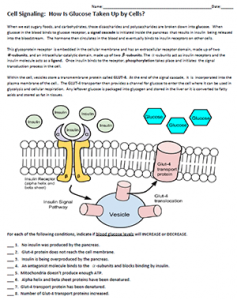
This activity was designed for AP biology to address the concept of cell signalling and the endocrine system. Students have already learned about feedback loops and how changes in glucose levels in the blood affect the production of insulin and glucagon.
This worksheet takes a closer look at the cell membrane and how insulin binds to a receptor which creates a signal cascade. The end result is the movement of the Glut-4 transport protein to the surface of the cell where it provides a channel for glucose to enter the cell via facilitated diffusion.
The graphic helps students visualize this process and is followed by questions about what would happen if there were changes in how the process works, like the inability of the receptor to bind with insulin, or if the cell lacked ATP.
In the last section, students are given brief descriptions on Type 1 and Type 2 diabetes. With Type 1, the pancreas is unable to make insulin, so the cells never get the signal to move the Glut-4 protein. With type 2, the receptors become desensitized to insulin, though the pancreas is producing insulin.
Students describe how both types of diabetes are similar and how they are different. Then they link the endocrine system to the nervous system, since both are in charge of cell communication.
I have used this activity in class as an open group discussion, which allows for students to process the image and think about it. The graphic shows how transport proteins move to the cell membrane after being constructed by ribosomes. The process is fairly complex.
Then they discuss their findings with a small group or the class.
The questions can be challenging for students, and I want to make sure they understand how each condition will affect the movement of glucose into the cell.
Grade Level: 10-12 (Advanced Placement)
Time Required: 20-30 minutes

